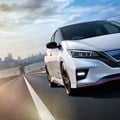I've been in the automotive industry throughout my career, yet I'm always amazed at the technological progress we've made over the years in developing cars that can park themselves, watch what's happening around you and even intervene when drivers are in trouble.

Mike Whitfield is the MD of Nissan Group of Africa
But, I’m most excited about the vehicle technology currently in development, which will give rise to a whole new driving experience, enabling us to move through life with greater confidence, exhilaration and connection to the world around us.
The future of clean and connected mobility with vehicles that can power city grids, learn from one another and offer increased utility is part of a bold, bright tomorrow that the automotive industry is working diligently towards as connected mobility will continue to be the dominant trend for many years to come.
EVs are solutions on wheels
As Africa moves towards cleaner energy sources, we’re witnessing an increased uptake in various modern energy technologies, including electric vehicles (EVs). Nissan brought the first fully electric EV, the LEAF, to South Africa in 2013 and has ensured that there are sufficient charging stations to support local EV customers.
Our ongoing EV development also includes the vision to make these vehicles more useful to customers by introducing convenient ways to utilise the car’s battery to store and share energy. Under the Nissan Energy plan, our EVs will be able to connect to energy systems to charge their batteries, power homes and businesses, and supply energy to power grids.
These are a few of the ways in which our EVs are offering incredible versatility:
- Vehicle to home (V2H): Nissan is working with partners to develop affordable equipment that will allow EV owners to use their cars as power sources for their homes to save money on electricity bills or to serve as a backup power source.
- Vehicle to building (V2B): Similar to V2H, V2B will utilise EV batteries to store energy for buildings and businesses. This system can involve hundreds of vehicles to ensure major cost savings for companies and full-scale trials are already underway.
- Vehicle to grid (V2G): In European trials, Nissan EVs are proving useful to electricity grids in that they are helping to balance energy networks and incorporate renewable energy. Nissan is also working on a way to let customers earn additional income by sharing their car’s energy.
V2G technology and taking a leadership role in the development of electric ecosystems is at the heart of Nissan’s goal of a more integrated society with offices, homes, schools, roads and vehicles all being fully interconnected, and powered by clean, sustainable energy. Nissan uses its V2G technology to achieve this as it’s a key element of Intelligent Integration, which is one of the three central pillars of the company’s Intelligent Mobility vision. The other two are Intelligent Drive (autonomous drive technology) and Intelligent Power (electrification).
How connected cars will change personal transportation
Artificial Intelligence (AI) and other Industry 4.0 technologies will bring automotive innovations and concepts together in connected vehicles that will redefine mobility.
Inside a connected car, we’ll experience all the information, entertainment and connection with the outside world that we have at home, or at work, and with technology such as Vehicle to Infrastructure, cars will communicate with other cars and infrastructure such as traffic lights.
This connectivity will enable autonomous cars and smart cities to form part of safety-centric networks designed to increase efficiencies while ultimately reducing traffic accidents.
While fully autonomous cars are still in early developmental and testing stages, a global view paints the picture of how serious some countries are about autonomous vehicles (AVs).
In the United States, many states have legalised the testing of AVs on their roads; in Canada, AVs have been in testing on public roads since 2016; in Finland, there are plans to eliminate the need for car ownership by 2025 as fully autonomous, on-demand public transport is expected to be operational; in Switzerland and the Netherlands, autonomous minibuses have been operating on fixed routes since 2016; in Singapore, there are driver-present autonomous taxis; and in Japan, testing of robot taxis started in 2016 with a view to having a robot taxi service in place for the 2020 Tokyo Olympic Games.
Earlier this year, Nissan North America announced an agreement with the NASA Ames Research Centre to collaborate on research and technology development for future autonomous mobility services.
While autonomous, connected cars will undoubtedly become part of our lives in the not-too-distant future, there are still many obstacles to overcome.
The cars, drivers and cities will all need to be ready for this new future and that will require commitment from automotive manufacturers, civil society and governments. However, given the possibility of safer passenger transportation, there is global optimism that all parties will come together to support the necessary developments.







































